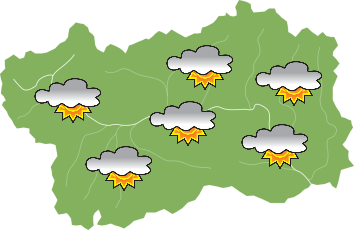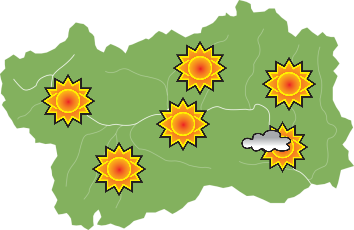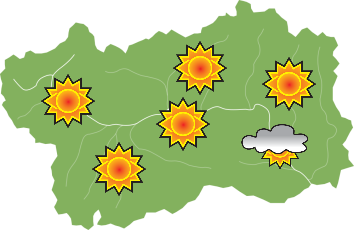In the Aosta Valley you can discover the rural life of the past and the traditions of the mountain in the ethnographic museums that collect and protect the rich historical heritage of rural communities.
Browse
Weather forecast
Meteo
Saturday 10 January


Sunday 11 January


Monday 12 January


Book your Holiday
Ethnographic museum "Un tempo, la veillà nella stalla"
Museums - Antey-Saint-AndréThe museum gives the possibility to discover the way of life in ancient times, when human being used to share the same room with animals, in order to warm naturally the place in which he lived.
In the kitchen we see a mother with her daughter doing housework, while the father and his son take care of calf, sheep, goat, hen and rabbit in the cowshed.
It is also possible to see the tools used in the past for agriculture works, now replaced more and more by modern and technological objects.
Hemp Ecomuseum
Museums - ChamporcherThe museum is situated inside an ancient building in the centre of the village of Chardonney, where is also located the “Lo Dzeut” cooperative.
In the museum it is possible to admire an ancient stable, a historical building and only example currently present in Champorcher. It is possible to see an old manual wooden loom and a warping frame.
Conservation work on the rooms, including a cellar (crotta), a rustic kitchen (meison) and a stable (boi), were varied in nature, however always in compliance with the structure, the fixtures and furniture, and their background and use.
The loom was restored to pristine condition to be used for demonstrations.
Maison de Cogne Gérard-Dayné Ethnographic Museum
Museums - CogneMaison Gérard Dayné is one of the best examples of Aosta Valley traditional architecture.
This particularly complex structure has been carefully restored. You can see the “cor”, the internal covered area that is typical of Cogne houses, the “beu”, the main room used in domestic life and the large barns which will house a long-term theme exhibition in the future.
Maison Gérard Dayné is a place where memories help to reflect on the conservation and valorisation of the architectural, historical and cultural heritage of the Alpine communities.
Situated in Sonveulla, on the edge of the ancient village, the structure, highly representative of local rural architecture, is a group of eight buildings arranged into an L-shape. Its current aspect dates back to the first half of the 19th century, at the end of a process of expansion that had begun possibly before the 18th century.
The varied nature of the complex and its specific characteristics, typical of the rural architecture of Cogne, are well suited to house a museum that tells the story of the traditional architecture, homes, family life, agricultural organisation and forest environment, mines, objects, sacred art, beliefs, legends, language and literature of Aosta Valley in former times.
Co-working service
Maison Gérard Dayné offers a corner where people who need working or studying can do it in tranquillity (reservation is recommended).
Ecomuseum "The local dairy at Treby"
Museums - DonnasThe building in the Tréby hamlet of Donnas, which from 1897 until 1980 hosted the activity of the local social dairy has a double historical and cultural interest as it testifies at the same time to the rural past of the village and to the centuries-old presence in Donnas of the Confraternity of the Holy Spirit, whose charitable activity has survived almost to the present day.
While the premises used up to thirty years ago as a social dairy preserve nowadays the furnishings and equipment for the delivery of milk and the subsequent dairy processing, as well as the documentation and records relating to the operation of the company itself, in the adjoining room, entirely frescoed , the evidence of the activity of the “Confrèrie du Saint-Esprit” emerges, existing since 1012 as reported on the fresco depicting the Last Supper.
You can admire various paintings attesting the work done by the brotherhood in favour of the community. The duty of the confraternity was in fact to translate faith into works of charity, distribute food to the poor and host the homeless in case of fire. The charitable activity of the confraternity continued for more than a century and a half after its official suppression in 1776.
The act establishing a local dairy at Treby dates back to the 25th July 1897.
Five years later, on the 21st May 1902, the dairy bought the buildings of the Brotherhood of the Holy Ghost, where it remained in activity until 1980, when the association broke up.
The building, given to the Municipality of Donnas in year 2000, has been restored and destined, in 2003, to ethnographic museum, furnished with the same equipment and materials originally used at the dairy.
Mid Mountain Ecomuseum
Museums - FontainemoreThe mid mountain ecomuseum is in Pra dou Sas, close to the entrance to the Mont Mars Natural Reserve. It is a beautiful mid-mountain village, whose buildings are used partly as a living museum.
A two-storey stone house has a stable on the lower floor and on the upper floor the room with the fireplace for processing milk and another one in which the family resided.
The nearby wooden rascard encloses the area used in the past for threshing rye and the area for conserving produce. The cellar contained the room for seasoning cheese.
Part of the rascard holds a collection of equipment of carpenters and other traditional professions.
Particular importance is given to the builders’ equipment, a typical profession of this town, for which its inhabitants were famous even abroad, where they were called to work during the warm season.
How to arrive
From the village of Fontainemore, continue a few kilometres along the regional road for Gressoney, then take the bridge on the right and follow on the road which leads to the Mont Mars Nature Reserve. Once you’ve crossed the bridge over the Lys river, continue along the road that leads to Pillaz-Pian Coumarial, then leave the fork road for Pillaz on the left and continue to Pra dou Sas, where you will find directions for the ecomuseum.
Maison Gargantua
Museums - GressanClose to the Côte de Gargantua regional nature reserve there is an ancient building that hosts Maison Gargantua.
Maison Gargantua is an ethnographic museum, an exhibition hall, an educational space, a sculpture laboratory and the departure point of some routes to discover the surrounding territory.
There are two itineraries starting from the Maison. The first one, inside, gives the chance of discovering the naturalistic aspects of both the reserve and the surroundings and gives information about past life. The second one, outside, allows the visitor to discover the routes of the Côte and of its surroundings thanks to two routes of different lengths.
A visit to the Maison makes us discover the ancient folk wisdom thanks to objects, pictures and decorations that show ancient professions and local customs and traditions, that might have been sometimes forgot, but that still are a significant part of the autochthonous culture.
Walser Ecomuseum
Museums - Gressoney-La-TrinitéThe Ecomuseum is made up of three buildings that lead visitors on a voyage of discovery through the Walser culture:
Country House - Puròhus
Typical house from the 18th century, with the authentic atmosphere of a Walser home, featuring the “wohngade”, which was the very heart of the working activity of the inhabitants, with one part used as a shelter for the animals and the other for the family. The two parts were separated by a wooden partition. This coexistence between man and animals was designed to make the most of the heat generated by the latter. Visitors can also see the fine vaulted cellar and the hayloft, with a range of tools used for traditional trades.
House Museum - Pòtzschhus
In the rooms of this ‘stadel’, the dialect name for the typical Walser house, permanent exhibitions dedicated to the local area are held. The Monte Rosa room tells about the evolution of the glaciers over time, the peaks conquest and its protagonists, technical developments in the history of mountaineering and the fascinating story of how the large bronze ‘Cristo delle Vette’ statue was placed on the Rosa glacier, at 4170 m. Another section is dedicated to the history and work of the ‘Angelo Mosso Institute’ and ‘Regina Margherita’ science laboratories (the latter is set up in the refuge of the same name, the highest in Europe, at 4554 m), the sites of the first studies of the effects of altitude on man. An area is also dedicated to the Krämertal - the Valley of the Walser Merchants. The room on the first floor, also home to the Office Régional du Tourisme Tourist Office, hosts an exhibition on the history of the traditional local costume, famous for its beauty and elegance.
Binò Alpelté hut
This is the third building of the Ecomuseum, consisting of a small house in the hamlet of Binò that was once used, from June to the end of September, for the exploitation of the pastures located close to the village. It consists of two adjoining buildings, built under the shelter of a single natural boulder, the ‘balma’, which acts as a roof and protects them from avalanches and falling stones, to which the area is exposed during winter and spring. The largest space was used for the night shelter of about twenty animals, including milking cows and calves, while the other one was used for milk processing. Open only during the summer period according to availability, but it can also be reached independently by following path no. 15.
Local History Museum Maison Bruil - Maison de l'alimentation
Museums - IntrodMaison Bruil, located in the hamlet Ville Dessus of Introd is one of the best examples of rural Gran Paradiso architecture.
It is an ancient rural house with several concentrated functions: all spaces needed for survival of people and animals were grouped together under a single roof.
The current shape is the result of a complex architectural evolution that can be dated back to between 1680 and 1856, the period in which different wings of the building were joined to form a single body.
The visit unravels on three floors through the typical rooms of a traditional house, restored to their original function. The “crotta”, the natural glacier , the “crotteun”, the “peillo”, the drying areas and the garret are some of the areas open to the public wishing to deepen its knowledge of traditional architecture.
The exhibition: food preservation
Maison Bruil has become also a permanent food exhibition, a journey through oral testimony, recorded since 1980 in several communities of the Region. In the towns where the land lies fallow for many months, populations are only able to settle down when they dispose of food resources that last from one harvest to the next.
Altitude and latitude reduce food production times and as a consequence extend preservation times for the items needed. Tradition and experience taught the mountain dwellers numerous preservation techniques based on different physical and chemical principles: cold, salting, drying, smoking, cooking, isolation from air and light.
L’Atelier du Goût
Maison Bruil contains a special area reserved to local products: Atelier du Goût.
This is a showcase area where you can discover the territory and its products; presentations of products and tasting show the techniques and cultural context in which foodstuffs and wine are created.
Atelier du Goût provides an answer to the growing demand for food-related themes and quality agricultural products; this takes place in an atmosphere where the senses are used as an instrument of knowledge, with a direct approach to form, fragrances and flavours and with personal interaction with vine-dressers, diaries, farmers, the real protagonists of the products presented.
The mystery of the forest
A Fantasy Game style visit formula that involves adults and children in search of clues to decipher and puzzles to solve. Inside the rooms of the large Maison Bruil, between the stable, the cellars, the kitchen, the small dairy and the attic, visitors will have to face a fascinating challenge against time and solve the intricate mystery
Les Villes-Dessus Dairy
This building was built on land purchased from the inhabitants of the villages of Les Villes-Dessus and Norat. Each family contributed a share proportional to the number of cows owned. Built between 1913 and 1914, the dairy had a cellar for maturing cheeses and was equipped with a water turbine connected to the churn and fed by an ancient spring. A room intended for the village school
The dairy worked continuously until the mid-1980s. Appropriately renovated, the dairy has become a ludic and interactive center dedicated to discovering the traditional milk supply chain, designed in particular for school groups and young people accompanied by their families.
- The dairy can be visited on the occasion of special events or by reservation for groups.
"La Maison des Anciens Remèdes" - the use of traditional herbal remedies
Museums - JovençanLa Maison des Anciens Remèdes has been set up in an old rural house built in the late 17th Century and used as a hay barn in the parish of Jovençan until the early 1950s. This building represents a place where nature meets popular culture made up of savoir-faire, legends, recipes and homemade remedies.
La Maison proposes a journey through the world of medicinal plants where the curative traditions of our ancestors overlap with modern scientific knowledge.
The plants
Each plant is unique and has a fascinating structure to discover. Thirty-eight main plants are described in the house, from the most common to the rarest, the most mysterious and those most popular in local culture. An itinerary allows visitors to learn and understand about these plants, and how the roots, stems, leaves, flowers and fruits are used.
The remedies
The plants can also be useful, in many ways. By watching videos revealing some popular traditional remedies, you can discover how at one time in basic peasant pharmacy women took on the role of the main custodians of the knowledge of plants and their virtues, as well as the preparation methods, doses and duration of various treatments.
La Bouteucca de l’Apotéquéro
In the Apothecary’s Workshop guests can explore the drawers where the plants are conserved, by looking, feeling and discovering their properties as well as their toxic effects. The _pots_illustrate the traditional uses, while the_showcases_on the walls reveal the curious features and secrets of the plants. You can also leaf through the great book to learn more about the remedies used by the inhabitants of these mountains.
Plants and the land
A place where you can discover the land and flora of the Aosta Valley, the smallest Italian region but offering a large natural assortment of smells and colours: historical herbaria, botanical gardens, nature reserves, educational vegetable gardens and one of the richest and most complex natural heritages in Italy and the Alps.
Discover with your senses
Head along The Scent Path, a sensory journey where you can learn to recognise the medicinal plants from their scent, choosing between twelve essential oils at your disposal, all natural and extremely pure. Then continue your discovery with the large living herbarium, placing your hands on the table to watch as earth, roots and flowers come to life and describe their intimate nature, colours, sounds and stories.
Learn while having fun
A dedicated space for children with traditional hobbies such as the Game of the goose, medicinal Sudoku, the Bouteucca de l’Apotéquéro Dominoes and interactive game areas to learn new things through play. Moreover, the young visitors can dress up as two plants, take part in an educational workshop and finally, compare their experiences of the microcosm of medicinal plants with their fellow travellers.
Each area of this Maison is a space that is constantly changing; just like in a field, so you can be certain of finding something different here next time!
''L'Homme et la Pente'' ethnographic museum
Museums - La SalleThe “L’Homme et la Pente” ethnographic museum is the heart of the valorisation project of the rural heritage of La Salle.
The museum holds equipment used in agriculture and family life, particularly from the 18th and 19th centuries.




-9424%20(1).jpg?v=638267413400000000)


-0103.jpg?v=638545307904593445)